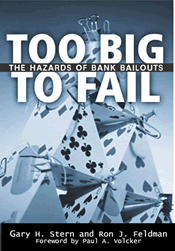Editor's note: The following excerpts are from Too Big to Fail: The Hazards of Bank Bailouts by Stern and Feldman, published by The Brookings Institution (2004) Brookings Institution Press.
Preface
In late 2001, following the tragic events of September 11, a medium-size broker-dealer firm headquartered in Minneapolis—MJK Clearing (MJKC)—experienced severe financial difficulty. It was alleged to the Federal Reserve Bank of Minneapolis that the failure of MJKC would spill over and severely impair around 200,000 retail customers, several brokerage firms involved in the stock-lending deal that initially caused the problems, and a variety of small brokerage houses throughout the Midwest for which MJKC provided back-office services. MJKC's lawyer argued that the firm was too big to fail (TBTF), that its failure would disrupt economic activity in the Midwest, and, therefore, that the Federal Reserve should provide assistance to it. Indeed, the leader of a second Reserve bank in the Midwest called Minneapolis to inquire about the possibility of spillover effects.
 The largest liquidation of a securities broker
by the Securities Investor Protection Corporation was hardly
a trivial event.1 However, the initial claims of financial and economic disruption
were thought at the time, and later demonstrated, to be exaggerated,
and no assistance was provided. The fact that MJKC's well-respected
representative raised TBTF concerns shows how deeply the ethos
of creditor protection in the name of financial stability permeates
the financial environment. More important, if TBTF arguments
are advanced in a case with only a hint of regional complications,
they certainly will present themselves in almost any failure of significance. Indeed,
a local newspaper columnist and a national banking association seemed
to find examples of contagion in the MJKC failure.2 Left to their own devices, policymakers could protect
creditors even when other options would prove superior and reforms
to prevent this undesirable outcome were available. Thus we viewed
the events as a warning: Too big to fail is no theoretical problem,
but rather a central public policy dilemma. This conclusion confirmed
earlier concerns.
The largest liquidation of a securities broker
by the Securities Investor Protection Corporation was hardly
a trivial event.1 However, the initial claims of financial and economic disruption
were thought at the time, and later demonstrated, to be exaggerated,
and no assistance was provided. The fact that MJKC's well-respected
representative raised TBTF concerns shows how deeply the ethos
of creditor protection in the name of financial stability permeates
the financial environment. More important, if TBTF arguments
are advanced in a case with only a hint of regional complications,
they certainly will present themselves in almost any failure of significance. Indeed,
a local newspaper columnist and a national banking association seemed
to find examples of contagion in the MJKC failure.2 Left to their own devices, policymakers could protect
creditors even when other options would prove superior and reforms
to prevent this undesirable outcome were available. Thus we viewed
the events as a warning: Too big to fail is no theoretical problem,
but rather a central public policy dilemma. This conclusion confirmed
earlier concerns.
Before the MJKC failure, in mid-2000 to be precise, we presented options for addressing the TBTF problem at a conference held at the University of Chicago Business School. Michael Mussa, then the research director for the International Monetary Fund, dismissed our options out of hand. He argued that governments cannot convince creditors of large banks that they will take losses if their bank fails. In short, too big to fail is an unsolvable problem. We later heard from equally distinguished audience members that, in fact, there was not a TBTF problem in the United States. Legislation passed in the early 1990s had eliminated the problem, and other countries could easily adopt the same reforms. In either case, the message was the same: Policymakers and the public should not spend much time worrying about how to address too big to fail.
We left the conference convinced that our previous, abbreviated work had failed to make our case. We had not adequately conveyed how policymakers could enact reforms that reduce creditors' expectations of a bailout. Moreover, we had not sufficiently established that earlier legislation had failed to fix the problem.
From such events came the impetus for a book-length treatment of the TBTF problem as well as the book's organization. In the first part, we warn readers that the TBTF problem is real, costly, and becoming more severe. In the second, we provide policymakers with options to address it. Too big to fail is not unsolvable, and this is the right time to address the problem—waiting for the next banking crisis can hardly improve our lot. ...
... The views in this book are not necessarily those of the Federal Reserve Bank of Minneapolis or the Federal Reserve System.
1 Securities Investor Protection Corporation, "2001 Set Record for Number of Customers Paid, Amount of Advances," news release, March 13, 2002.
2 Lotterman, Ed, "Stockwalk Situation Shows How Quickly Failure Can Spread," St. Paul Pioneer Press, October 7, 2001. Stone, Pierce. 2002. "Testimony before the Financial Institutions and Consumer Credit Subcommittee, House Financial Services Committee, April 25th."
Chapter 1
Introduction: Our Message and Methods
Summarizing the warnings and options of this book requires a little background for the uninitiated. We start with the trivial observation that banks fail.1 Some banks fail without notice. Other failing banks capture the attention of policymakers, often because of the bank's large size and significant role in the financial system. Determining the appropriate policy response to an important failing bank has long been a vexing public policy issue. The failure of a large banking organization is seen as posing significant risks to other financial institutions, to the financial system as a whole, and possibly to the economic and social order. Because of such fears, policymakers in many countries—developed and less developed, democratic and autocratic—respond by protecting uninsured creditors of banks from all or some of the losses they otherwise would face. These banks have assumed the title of "too big to fail" (TBTF),2 a term describing the receipt of discretionary government support by a bank's uninsured creditors who are not automatically entitled to government support (for simplicity we use creditors and uninsured creditors synonymously from here on).3
To the extent that creditors of TBTF banks expect government protection, they reduce their vigilance in monitoring and responding to these banks' activities. When creditors exert less of this type of market discipline, the bank may take excessive risks. TBTF banks will make loans and other bets that seem quite foolish in retrospect. These costs sound abstract but are, in fact, measured in the hundreds of billions of dollars of lost income and output for countries, some of which have faced significant economic downturns because of the instability that too big to fail helped to create. This undesirable behavior is frequently referred to as the "moral hazard" of TBTF protection. Such behavior wastes resources.
Our Message
Despite some progress, our central warning is that not enough has been done to reduce creditors' expectations of TBTF protection. Many of the existing pledges and policies meant to convince creditors that they will bear market losses when large banks fail are not credible and therefore are ineffective. Blanket pledges not to bail out creditors are not credible because they do not address the factors that motivate policymakers to protect uninsured bank creditors in the first place. The primary reason why policymakers bail out creditors of large banks is to reduce the chance that the failure of a large bank in which creditors take large losses will lead other banks to fail or capital markets to cease working efficiently.
Other factors may also motivate governments to protect uninsured creditors at large banks. Policymakers may provide protection because doing so benefits them personally, by advancing their career, for example. Incompetent central planning may also drive some bailouts. Although these factors receive some of our attention and are addressed by some of our reforms, we think they are less important than the motivation to dampen the effect of a large bank failure on financial stability.
Despite the lack of definitive evidence on the moral hazard costs and benefits of increased stability generated by TBTF protection, the empirical and anecdotal data, analysis, and our general impression—imperfect as they are—suggest that TBTF protection imposes net costs. We also argue that the TBTF problem has grown in severity. Reasons for this increase include growth in the size of the largest banks, greater concentration of banking system assets in large banks, the greater complexity of bank operations, and, finally, several trends in policy including a spate of recent bailouts.
Our views are held by some, but other respected analysts come to different conclusions. Some observers believe that the net costs of TBTF protection have been overstated, while others note that some large financial firms have failed without their uninsured creditors being protected from losses. However, even analysts who weigh the costs and benefits differently than we do have reason to support many of our reforms. Some of our recommendations, for example, make policymakers less likely to provide TBTF protection and address moral hazard precisely by reducing the threat of instability. Moreover, our review of cases where bailouts were not forthcoming suggests that policymakers are, in fact, motivated by the factors we cite and that our reforms would push policy in the right direction.
A second camp believes that TBTF protection could impose net costs in theory, but in practice legal regimes in the United States—which other developed countries could adopt—make delivery of TBTF protection so difficult as to virtually eliminate the TBTF problem.
We are sympathetic to the general and as yet untested approach taken by U.S. policymakers and recognize that it may have made a dent in TBTF expectations. In the long run, however, we predict that the system will not significantly reduce the probability that creditors of TBTF banks will receive bailouts. The U.S. approach to too big to fail continues to lack credibility.
Finally, a third camp also recognizes that TBTF protection could impose net costs but believes that there is no realistic solution. This camp argues that policymakers cannot credibly commit to imposing losses on the creditors of TBTF banks. The best governments can do, in their view, is accept the net costs of TBTF, albeit with perhaps more resources devoted to supervision and regulation and with greater ambiguity about precisely which institutions and which creditors could receive ex post TBTF support.
Like the third camp, we believe that policymakers face significant challenges in credibly putting creditors of important banks at risk of loss. A TBTF policy based on assertions of "no bailouts ever" will certainly be breached. Moreover, we doubt that any single policy change will dramatically reduce expected protection. But fundamentally we part company with this third camp. Policymakers can enact a series of reforms that reduce expectations of bailouts for many creditors at many institutions. Just as policymakers in many countries established expectations of low inflation when few thought it was possible, so too can they put creditors who now expect protection at greater risk of loss.
The first steps for credibly putting creditors of important financial institutions at risk of loss have little to do with too big to fail per se. Where needed, countries should create or reinforce the rule of law, property rights, and the integrity of public institutions. Incorporating the costs of too big to fail into the policymaking process is another important reform underpinning effective management of TBTF expectations. Appointment of leaders who are loath to, or at least quite cautious about, providing TBTF bailouts is also a conceptually simple but potentially helpful step. Better public accounting for TBTF costs and concern about the disposition of policymakers could restrain the personal motivations that might encourage TBTF protection.
With the basics in place, policymakers can take on TBTF expectations more credibly by directly addressing their fear of instability. We recommend a number of options in this regard. One class of reforms tries to reduce the likelihood that the failure of one bank will spill over to another or to reduce the uncertainty that policymakers face when confronted with a large failing bank. These reforms include, among other options, simulating large bank failures and supervisory responses to them, addressing the concentration of payment system activity in a few banks, and clarifying the legal and regulatory framework to be applied when a large bank fails.
Other types of reforms include reducing the losses imposed by bank failure in the first place and maintaining reforms that reduce the exposure between banks that is created by payments system activities. These policies can be effective, in our view, in convincing public policymakers that, if they refrain from a bailout, spillover effects will be manageable. Such policies therefore encourage creditors to view themselves at risk of loss and thus improve market discipline of erstwhile TBTF institutions.
We are less positive about other reforms. A series of reforms that effectively punish policymakers who provide bailouts potentially also could address personal motivational factors. However, we are not convinced that these reforms are workable and believe that they give too much credence to personal motivations as a factor to explain bailouts. The establishment of a basic level of supervision and regulation (S&R) of banks should help to restrict risk-taking, although we view S&R as having important limitations.
Finally, policymakers have a host of other available options once they have begun to address too big to fail more effectively. For example, policymakers could make greater use of discipline by creditors at risk of loss. Bank supervisors could rely more heavily on market signals in their assessment of bank risk-taking. Deposit insurers could use similar signals to set their premiums.
One may agree with our arguments in concept but find them lacking in real-world pragmatism or realpolitik. A compelling case for relying on analytical rather than political principles in addressing the failure of large banks was made nearly thirty years ago—a full decade before the term too big to fail became commonplace:
To many practical people the suggestion that a large bank be allowed to fail may seem to represent dogmatic adherence to standard economic doctrine, a victory of ideology over pragmatic common sense. A pragmatic position is to argue that, yes, business failures do serve a useful function, but in the specific case of a large bank, the costs of allowing failure outweigh the costs of supporting it. After all, the social costs of failure are immediate, while the advantages of permitting failure are indirect and removed into the future. But this pragmatic position should be rejected because it ignores externalities over time. If we prop up a large bank because the direct costs of doing so outweigh the cost of allowing it to fail, then the next time a large bank is in danger of failing it is likely to be propped up too. But in the future the same benefit will then probably be accorded to medium-sized banks. And from there it is likely to spread to small banks, to other financial institutions, and ultimately to other firms. When one includes the cost of moving down this slippery slope in the cost of saving a large bank, then the costs of allowing it to fail may seem small by comparison. At a time when devotion to pragmatism is so much in the air, it is useful to consider also the benefits of sticking to one's principles even in hard cases.4 ...
Our Methods
... In terms of audience, we intend this book to help the wide range of staff practitioners, as well as the policymakers they support, to confront the TBTF problem. Although such an audience has a growing appreciation for concepts like moral hazard and the reasoning of economists, it is unlikely to find a treatment of the relevant issues that is suitable for academic journals to be approachable or convincing. Instead, it is likely to value clarity, concreteness, and conclusions that can be internalized. ...
... The truth, as demonstrated by rigorous analysis and derived through consensus, does not exist when it comes to many of the issues related to too big to fail. For some issues, the relevant data have not been collected and perhaps cannot easily be collected in any reasonable time period. For example, there is no comprehensive list of countries in which uninsured creditors of banks have received government protection. Records describing the size and type of bailouts that creditors have received are not readily available. Simply put, the basic facts are elusive. More generally, data on and applied analysis of too big to fail are made quite difficult by the implied nature of the support. To be sure, some data have been collected and some analysis completed. Such work is often based on an after-the-fact review of a single event with real limitations because of a lack of scientific controls. There is also theoretical work, but it often abstracts so far from institutional detail as to provide little guidance. These models do not let policymakers know if they should support creditors of one large bank but not another.
As a result, the environment for policymakers is characterized by opaqueness and uncertainty. Policymakers and their staffs could wait until a long-term research program is complete before they take action. Acting today with sub-par information could actually make things worse, and history is replete with such cases. But waiting for a final answer does not seem realistic to us. A recent conference on the Great Depression revealed strong disagreement on the underlying causes of an event that is more than seventy years old.5
Policymakers frequently play the role of emergency room doctor. Their actions should be informed by basic research, but they cannot wait for final results from exhaustive laboratory experiments before operating. Given that policymakers will often act sooner rather than later, it seems reasonable to try to take the best available information and combine it with economic reasoning that has passed the tests of time and experience. We hope the result assists staff and policymakers sort through the options that await them in triage. ...
1 We
use the term "bank" broadly to describe depositories whose
liabilities are backed by implicit and explicit government support
as well as their holding companies.
2 Although TBTF terminology
has been applied to nonfinancial firms and subnational governments,
we focus on banks and explain this decision in chapter 2.
3 Too big to fail
is a misleading term in several ways—which we describe in chapter
2—but we continue to use it because it is established in the
policy debate.
4 Mayer, Thomas.
1975. "Should Large Banks Be Allowed to Fail?" Journal
of Financial and Quantitative Analysis 10 (November): 603-10.
5 Fettig, David. 2000.
"Something Unanticipated
Happened: Telling Some 'Neo' Stories about the Great Depression of
the 1930s." Federal Reserve Bank of Minneapolis Region 14 (December): 19-21, 44-47. Rolnick, Arthur J. 1999.
“In This Issue.” Federal Reserve Bank of Minneapolis Quarterly Review 23
(Winter): 1.
Chapter 14
Summary: Talking Points on Too Big to Fail
We began the volume with a summary of our arguments and an identification of our target audience, namely policymakers, their staffs, and other professionals seeking to influence policy. We hope that these professionals convey our main points to their bosses and clients and that the bosses and clients internalize our story. At the risk of trivializing the process, convincing higher-ups these days requires short oral briefings, PowerPoint presentations, or summary memos. To help with those communications and recognizing that a reader probably does not want or need a traditional summary at this point, we list some talking points on too big to fail.
Three Bottom Lines
First, the TBTF problem has not been solved, is getting worse, and leads, on balance, to wasted resources.
Second, although expectations of bailouts by uninsured creditors at large banks cannot be eliminated, they can be reduced and better managed through a credible commitment to impose losses: policymakers can establish credible commitments by addressing and reducing the motivation for bailouts.
Third, although other reforms could help to establish a credible commitment, policymakers should give highest priority to reforms limiting the chance that one bank's failure will threaten the solvency of other banks.
We now provide supporting points for these conclusions.
The Problem
- Even though they are not entitled to government protection, uninsured creditors of a large or systemically important bank believe they will be shielded from at least part of the loss in the event of bank failure.
- Anticipation of government protection warps the amount and pricing of funding that creditors provide a TBTF bank, which, in turn, leads banks to take excessive risk and make poor use of financial capital. The costs of poor resource use resulting from TBTF guarantees appear to be quite high. We believe these costs exceed the benefits of TBTF coverage in most cases, but even those who weigh the costs and benefits differently should be able to support many of our reforms.
- Expectations of TBTF coverage have likely grown and become more strongly held because more banks are now "large" and because a smaller group of banks controls a greater share of banking assets and provides key banking services. In addition, banks have become increasingly complex, making it more difficult for policymakers to predict the fallout from bank failure and to refuse to provide subsequent coverage to uninsured creditors.
- Reforms over the last decade aiming to limit TBTF protection, including those adopted in the United States, are unlikely to be effective in the long run (although they have yet to be tested and may have made a dent in TBTF expectations).
Commitment as the Solution
- In order to change the expectations of bailouts, policymakers must convince uninsured creditors that they will bear losses when large banks fail; changes in policy toward the uninsured must involve a credible commitment.
- A credible commitment to impose losses must be built on reforms directly reducing the incentives that lead policymakers to bail out uninsured creditors.
- Reforms that forbid coverage for the uninsured are not credible because they do not address underlying motivations and are easily circumvented.
- Policymakers have considerable experience in establishing credible commitments in the setting of monetary policy. The experience of monetary policy over the last two decades demonstrates the feasibility of reducing long-held expectations, such as those likely held by uninsured creditors of large banks.
Specific Motivations and Reforms
- The most important motivation for bailouts is to prevent the failure of one bank from threatening other banks, the financial sector, and overall economic performance. To reduce that motivation, we recommend that policymakers in developed countries take three general steps: Enact policies and procedures that would reduce their uncertainty about the potential for spillovers; implement policies that directly limit creditor losses or allocate losses such that market discipline increases without an excessive increase in instability; consider or follow up on payments system reforms that reduce the threat of spillovers.
- Reforms that reduce policymaker uncertainty include the following: Increase supervisory planning for, and simulation of, a large bank failure; undertake targeted efforts that reduce the likelihood and cost of failure for banks dominating payment markets; make legal and regulatory adjustments that clarify the treatment of bank creditors at failure; and provide liquidity more rapidly to uninsured creditors.
- Reforms that could address concerns of excessive creditor loss include the following: close institutions before they can impose large losses; require banks in a weak position to increase the financial cushion to absorb losses; impose rules that require creditors to absorb at least some loss when their bank fails (for example, requiring coinsurance); and allow for select coverage of the nominally uninsured while, in general, making it more likely that creditors will suffer losses.
- Although payments system reforms are quite complex in implementation, they are fairly straightforward in concept. One type of reform would eliminate or significantly limit the amount that banks owe each other through the payments system. A second type of reform would establish methods by which a bank owed funds by a failing institution could offset losses (for example, by seizing collateral).






